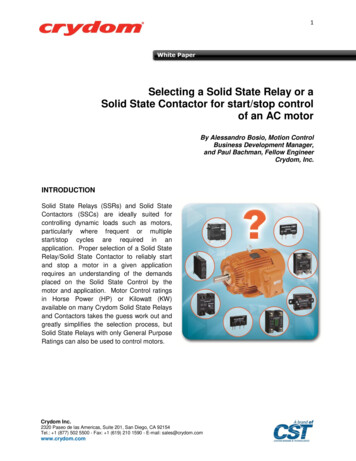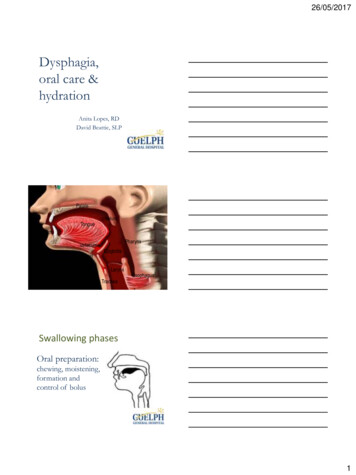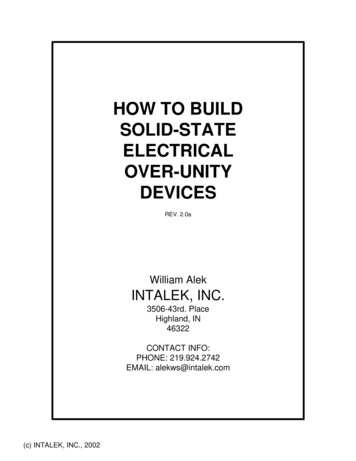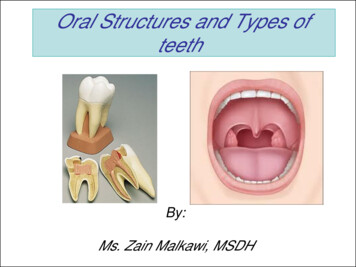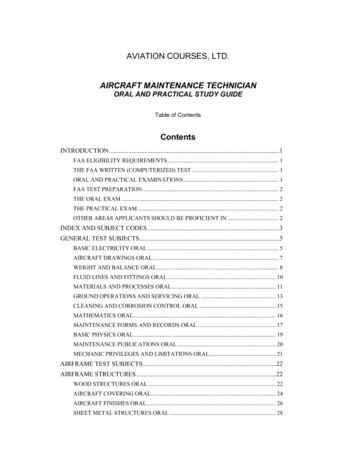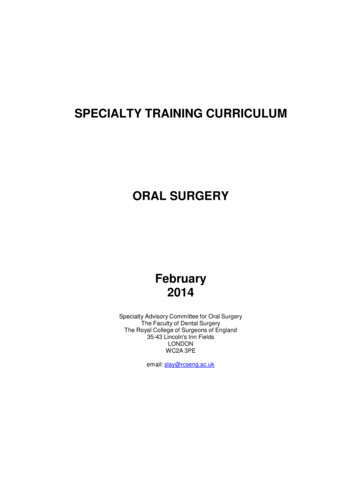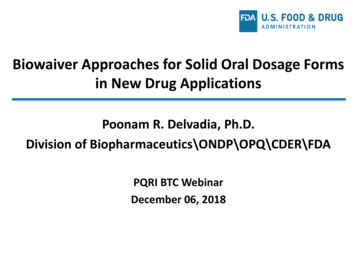
Transcription
Biowaiver Approaches for Solid Oral Dosage Formsin New Drug ApplicationsPoonam R. Delvadia, Ph.D.Division of Biopharmaceutics\ONDP\OPQ\CDER\FDAPQRI BTC WebinarDecember 06, 2018
DISCLAIMERThe presentation reflects the views of thepresenter and should not be construed torepresent FDA’s views or policies2
Presentation Outline Role of Biopharmaceutics In Vivo Bioavailability (BA) / Bioequivalence (BE) Assessment In Vitro and In Vivo Bridging for Assessment of Multiple Strengths andProduct Changes Biowaivers Biowaiver Approaches and Case Examples––––21 CFR 320.22(d)(2) Based ApproachBiopharmaceutics Classification System (BCS) Based ApproachRisk Assessment for bridging drug product changes and multiple strengthsSafe Space Approach Bracketing Approach Virtual BE In Vitro In Vivo Correlation (IVIVC) Concluding Remarks3
Role of BiopharmaceuticsDrug Product QualityCriticalMaterial/Process/Quality Attributes(CMA, CPP, CQA)PatientIn Vivo Performanceof Drug ProductBIOPHARMACEUTICSe.g., In VitroDissolutionScience and Risk Based ApproachClinically Relevant Specificationse.g., Bioavailability(BA)/Bioequivalence(BE) dataConsistentTherapeutic Effect4
In Vivo BA/BE Assessment Bioavailability – Rate and extent of drug exposure Bioequivalence – Absence of significant difference in the rateand extent of drug exposure These in vivo studies required as per § 21 CFR 320.21 for thedrug product approval Pivotal role in Drug Product’s Life-Cycle (Pre- and Post- Approval)– To support major formulation and manufacturing changes– To support the approval of multiple strengths§ 21 CFR 320.1; § 21 CFR 314.35
Risk Level Assessment of Formulation/Manufacturing Changes Type of bridging needed based on the level of risk resultingfrom CMC changes and impact of change on product qualityand in vivo performanceIn VivoIn Vitro BridgingBridging(BA/BE studies)Minor ChangesMajor ChangesUnlikely to have anydetectable impactLikely to have asignificant impactProductStrengthsBiowaiversModerate ChangesCould have asignificant impactFDA SUPAC IR Guidance (1995)FDA SUPAC MR Guidance (1997)6
Biowaivers Waiver of In Vivo BA/BE Studies– Requirements met as outlined in § 21 CFR 320.22– Supported by in vitro tests (e.g., dissolution testing)N 101 Biowaiver Requests(Solid Oral Dosage Forms)(Year 2008 - 2015)Biowaiver isnot neededBiowaiver isApplicable7
Biowaiver Approaches forSolid Oral Dosage FormsCFR21 CFR 320.22(d)(2)BCSBiowaiverApproachesSafe SpaceBracketing ApproachVirtual BEIVIVCRisk Assessment** Applicable to bridge product changes and strengths when waiver requirements are not met21 CFR 320.22FDA Guidance for Industry. Waiver of In Vivo BA/BE Studies for IR Solid Oral Dosage Forms Based on a Biopharmaceutics Classification System. December 2017FDA Guidance for Industry – Extended Release Oral Dosage Forms : Development, Evaluation, and Application of In Vitro/In Vivo Correlations8
Biowaiver Approaches forSolid Oral Dosage FormsN 101 Biowaiver Requests(Solid Oral Dosage Forms)(Year 2008 - 2015)Dissolution – One of the key elements in these biowaiver approaches9
21 CFR 320.22(d)(2) Based Biowaiver ApproachCFR21 CFR 320.22(d)(2)BCSBiowaiverApproachesSafe SpaceBracketing ApproachVirtual BEIVIVCRisk Assessment*10* Applicable to bridge product changes and strengths when waiver requirements are not met
21 CFR 320.22(d)(2) Based Biowaiver Applicable for demonstration of product strength equivalence BA/BE can be demonstrated by an in vitro testing in lieu of an in vivo study forproduct strengths not tested in vivo if these strengths meet all the criteria setforth in the CFR–––––––––In Vivo BA/BE data on the reference strength (commonly highest strength)Same Dosage FormSame Manufacturing ProcessCompositional ProportionalityIn Vitro Dissolution SimilarityPK linearity over therapeutic dosage rangeSame drug release mechanism (MR solid oral dosage forms)Demonstration of the clinical need of the proposed strength (Higher strength)Clinical safety and/or efficacy data on the proposed dose21 CFR 320.22FDA Draft Guidance for Industry - Bioavailability and Bioequivalence Studies Submitted in NDAs or INDs — General Considerations (2014)11
Strength Dependent DissolutionIn vitro strength dependent dissolution profile is defined as thedifference in drug dissolution profiles among strengths of thesame oral drug product, i.e., there is dissolution dissimilaritybetween test strength and reference strength(e.g., similarity factor f2 50)12
21 CFR 320.22(d)(2)Case Example 1 – Strength Dependent Dissolution Drug Product X - Drug A Immediate release tablet Two strengths BCS Class 2 drug substance– pH dependent solubility: Solubility decreases with increase in pH An in vivo BE study bridging lower strength (Phase 2 formulation) andhigher strength [Phase 3/to-be-marketed formulation (TBM)]– Major Formulation Change (Phase 2 to Phase 3)– BE demonstrated for phase 2 and phase 3 formulation– No PK data for lower strength (TBM) Biowaiver request for lower strength13Suarez-Sharp, S.; Delvadia, P.R., et. al. Regulatory Perspectives on Strength-Dependent Dissolution Profiles and Biowaiver Approaches for Immediate Release (IR) Oral Tablets in New Drug Applications. AAPSJ.2016. May 18(3): 578-588
Case Example 1 – Strength Dependent Dissolution Multimedia dissolution comparing two strengths– pH 1.2, pH 4.5, pH 6.8– Dissolution similar at pH 1.2– Dissolution not similar at pH 4.5 and 6.8 (f2 50) Dissolution dissimilarity– Strength dependent dissolution– Sink condition differencespH 4.514
Case Example 1 – Strength Dependent DissolutionpH 4.5 Vertical dissolution comparisonMultiunit dissolution similarity inpH 4.5 and pH 6.8 supportedbiowaiverMultiunit Dissolutionf2 50pH 4.515
21 CFR 320.22(d)(2) Based Biowaiver - Summary 21 CFR 320.22(d)(2) – Dissolution similarity is a requirement Factors causing strength dependent dissolution– Sink condition differences– Formulation differences– Manufacturing process/Quality attribute differences (e.g., Hardness) Other strategies to support biowaiver– Horizontal dissolution comparison– Indirect bioequivalence (BE) bridge– Bracketing BE Approach Selection of the strategy when strength dependent dissolution is observed– Factor causing strength dependent dissolution– Type of in vitro/in vivo data generated as part of drug development16Suarez-Sharp, S.; Delvadia, P.R., et. al. Regulatory Perspectives on Strength-Dependent Dissolution Profiles and Biowaiver Approaches for Immediate Release (IR) Oral Tablets in New DrugApplications. AAPSJ. 2016. May 18(3): 578-588
Biopharmaceutics Classification System(BCS) Based BiowaiverCFR21 CFR 320.22(d)(2)BCSBiowaiverApproachesSafe SpaceBracketing ApproachVirtual BEIVIVCRisk Assessment*17* Applicable to bridge product changes and strengths when waiver requirements are not met
BCS Based Biowaiver Approach BCS framework – Drug substance categorized into four classesBiowaiver application for IR solidoral dosage forms containing BCSclass 1 and 3 drug substances Drug product – rapidly dissolving ( 85% in 30 min) or very rapidly dissolving( 85% in 15 min) in multimediaFDA Guidance for Industry. Waiver of In Vivo BA/BE Studies for IR Solid Oral Dosage Forms Based on a Biopharmaceutics Classification System. December eutical-classification-system-57 fig3 1164613218
BCS Based Biowaiver ApproachData To Support BCS Based Biowaiver RequestBCS class 1 drug productsHighly soluble (pH 1- 6.8)Highly permeableBCS class 3 drug productsHighly soluble (pH 1- 6.8)T and R products are rapidly dissolving( 85% in 30 min)T and R products are very rapidly dissolving( 85% in 15 min)No excipients that affect rate or extent of drugabsorptionQualitative sameness and quantitative similarityin formulationSimilarity in dissolution profiles between T and R Similarity in dissolution profiles between T and RT – Test ProductR – Reference Product19
BCS Based BiowaiverCase Example 2 – Biowaiver for Pharmaceutical Alternative BCS class 1 based biowaiver for pharmaceutical alternativedrug product– Change from tablet to capsule Data to support– High solubility– High permeability– Rapid dissolution in multimedia ( 90% in 10 min)– Excipient differences were not expected to alter BA– Dissolution similarity between test and reference products20
BCS Based Biowaiver – Summary Common deficiencies– Insufficient number of pH conditions (as per BCS guidance) to define pHsolubility profile– Absence of analytical validation report– Lack of stability indicating assay– Incomplete information on permeability studies– Lack of data on gastrointestinal stability of drug– Lack of dissolution information, etc. Complete set of data and adequate justification to support BCSdesignation and biowaiver requests are necessary21
Risk Assessment Based BiowaiverCFR21 CFR 320.22(d)(2)BCSBiowaiverApproachesSafe SpaceBracketing ApproachVirtual BEIVIVCRisk Assessment*22* Applicable to bridge product changes and strengths when waiver requirements are not met
Risk AssessmentCase Example 3 – Support Minor Manufacturing Change Risk Assessment to support minor change when dissolution similarity failed Immediate release tablet, High solubility drug substanceTBM – To-Be-Marketed; CTF – Clinical Trial FormulationP R Delvadia, S S Sharp, J Z Duan, and P R Seo. Risk Based Approach for Biowaiver Application to Immediate Release (IR) Solid Oral Dosage Forms. Poster Presentation. AAPS 201623
Risk AssessmentCase Example 3 – Support Minor Manufacturing Change24
Risk Assessment Based Biowaiver - Summary Consideration of comprehensive analysis of in vitro and invivo information in the context of CMC changes– Biopharmaceutics characteristics API and formulation characteristics– Control strategy (CMAs, CPPs, in-process controls)– Exposure/response relationship– Safety profile Comprehensive analysis can lead to successful bridgingcentered on risk-based approach25
Safe Space Based BiowaiverCFR21 CFR 320.22(d)(2)BCSBiowaiverApproachesSafe SpaceBracketing ApproachVirtual BEIVIVCRisk Assessment*26* Applicable to bridge product changes and strengths when waiver requirements are not met
Safe Space Approaches Safe space – Boundaries defined by dissolution profiles within which drugproduct batches are anticipated to be bioequivalent to one anotherBioequivalentSafe SpaceOutside of Safe SpaceIn vivo performance not known27Sandra Suarez-Sharp, et. al. Applications of Clinically Relevant Dissolution Testing. Workshop Summary Report. The AAPS Journal (2018) 20: 93
Safe Space Approaches Safe space can be defined by – Bracketing approach, virtual bioequivalence, and IVIVCApplication for both setting clinically relevant drug product specification and gainingregulatory flexibility i.e., biowaiverSafe space based on Approach B, C1, and C2 is wider than based on pivotal clinical trialbatchesSelection of the safe space approach depends on the type of data availableIVIVC based safe spaceVirtual BE based safe spaceBracketing Approach based safe space28Sandra Suarez-Sharp, et. al. Applications of Clinically Relevant Dissolution Testing. Workshop Summary Report. The AAPS Journal (2018) 20: 93
Safe Space - Bracketing Approach29
Bracketing Approach Demonstration of bioequivalence between strengths or drug productvariants representing the extremes in dissolution profiles. All dissolutionprofiles falling within the BE dissolution bounds are considered to be BE.BioequivalentSafe SpaceOutside of Safe SpaceIn vivo performance not known30
Bracketing Approach Based Safe SpaceCase Example 4 – Bridging of Intermediate Strength Drug Product B - IR/ER Tablet (Drug X and Drug Y respectively) Three strengths Both IR and ER components contain BCS Class 3 drug substances Lowest and highest strength bioequivalent to the respective strength of thereference product Biowaiver request for intermediate strength For Drug Y and for intermediate strength,– Multimedia dissolution similar for Drug Y (f2 50) For Drug X and for intermediate strength,– Multimedia dissolution not similar for Drug X (f2 50)31
Case Example 4 – Bracketing Approach Based Safe Space Dissolution profile of Drug X for IS is within the dissolution bounds of LSand HS that are bioequivalentLS – Lowest StrengthIS – Intermediate StrengthHS – Highest Strength32
Bracketing Approach - Summary Leverage clinical BE studies conducted as part of drugdevelopment program– Study of different strengths– Study of critical material attributes, critical formulation variables,and/or critical process parameters Successful bracketing approach will provide a safe spaceleading to regulatory flexibility33
Safe Space – Virtual Bioequivalence (BE)34
Virtual BE Based Safe Space Virtual BE study using physiologically based biopharmaceutics modeling (PBBM) approach to demonstratebioequivalence between test and reference drug products PBBM uses mechanistic models which integrate physicochemical properties of API, physiologicalconditions, and formulation variables (e.g., dissolution profile as a function of formulation variables) forprediction of systemic exposure vs timeVerified ModelVirtual BE StudyTest and Reference are BESafe SpaceTest drug product – virtual (green) dissolution profileReference drug product – observed (blue) dissolution profile35
Virtual BE Based Safe SpaceSafe SpaceXavier J. H. Pepin, Talia R. Flanagan et. al., Justification of Drug Product Dissolution Rate and Drug Substance Particle Size Specifications Based on Absorption PBPK 36Modeling for Lesinurad Immediate Release Tablets. Molecular Pharmaceutics. 2016. 13, 3256 – 3269.
Virtual BE - Summary Virtual BE is a valuable tool– Gaining experience in regulatory applications e.g., setting clinically relevant drugproduct specification However, biowaiver application is limited– Lack of confidence on the model Thorough model verification to increase confidence in the model prediction– Verification using BE and non-BE batches to evaluate predictability of the model The regulatory application of virtual BE based safe space will depend onthe data used to develop and verify the relationship37Sandra Suarez-Sharp, et. al. Applications of Clinically Relevant Dissolution Testing. Workshop Summary Report. The AAPS Journal (2018) 20: 93
Safe Space – In Vitro In Vivo Correlation (IVIVC)38
IVIVC “A predictive mathematical model describing relationship between an invitro property (e.g., dissolution time profile) and a relevant in vivoresponse (concentration time profile) of a drug product” Goal: to predict the in vivo plasma concentration-time profile Application:– To support major formulation/manufacturing changes (biowaiver)– To support product strength equivalence (biowaiver)– To set drug product specifications [e.g., dissolution, hardness] Categories of IVIVC––––Level A,Level B,Level C,Multiple Level CIVIVCFDA Guidance for Industry – Extended Release Oral Dosage Forms : Development, Evaluation, and Application of In Vitro/In Vivo CorrelationsSharp, S.S. et. al. (2016). Regulatory Experience in IVIVC in New Drug Applications. The AAPS Journal.http://www.pharmogo.com/training.php?act show&id 3039
Level A IVIVCCase Example 5 – Manufacturing site change and product strength equivalence (MR product) Drug Product C (Drug D Drug E)– Fixed Dose Combination (FDC) Extended Release Capsule (IR ER component)–Drug D – IR granules; Drug E – ER beads– Two strengths Biowaiver Request– Lower strength– Manufacturing site change Linkage for IR component was supported by comparative in vitro dissolution For ER component,– Level A IVIVC established for single entity product was applied for FDC product40
Level A IVIVCTreatment BInternal Validation Treatment CTwo stage deconvolution methodUnit impulse response from IR formulationTwo formulation/release rates for model development41
Application of Level A IVIVC for FDC ProductFDC ER productLower strengthDifference in IVIVC basedCmax and AUCprediction ( 20%)(Clinical manufacturing site)Manufacturing Site ChangeDifference in IVIVC based Cmax and AUC prediction ( 20%)FDC ER productHigher strengthDrug A 20 mg (IR component)Drug B 140 mg (ER component)(Clinical manufacturing site)BioequivalentSingle entity product(Commercial manufacturing site)FDC ER productLower and Higher strengthDrug A 20 mg (IR product)Successful Cross ValidationDrug A 20 mg (IR component)Drug B 70 mg (ER component)Product Strength EquivalenceDrug B 140 mg (ER product)Successful Level A IVIVC42
IVIVC based Safe SpaceFastest and SlowestRelease FormulationsSafe Space43
IVIVC – Summary Advantages– Reduced regulatory burden/Gain regulatory flexibility– Supports clinically relevant drug product specification settings– Potential of wider drug product specifications– Approval of meaningful design space in Quality by Design framework Low success rate– Insufficient considerations of in vivo situation with conventional IVIVCmethodologies Physiologically based/Mechanistic IVIVC has promising advantagesto address limitation with conventional methodologiesSandra Suarez-Sharp, Min Li., et. al. Regulatory Experience with In Vivo In Vitro Correlations (IVIVC) in New Drug Applications. The AAPS Journal. 18 (6), Nov 2016. 1379 - 139044
Concluding Remarks Approaches for Biowaiver––– Establishment of safe space–– Selection of approach depends on the type of in vitro and in vivo data availableDissolution is one of the key elementsEstablishment of in vitro – in vivo link and clinical relevance for biowaiver applications and lifecyclemanagement of drug productsLeveraging knowledge gained from product development stages and biopharmaceutics principles helpbuild safe space for regulatory flexibilityIVIVC is gold standard for gaining regulatory flexibilityPhysiologically based biopharmaceutics modeling is promising for––––Regulatory flexibility (wider specifications, biowaivers, study of the excipient effect from BCS perspective)Establishment of clinically relevant drug product specificationsUnderstanding of the impact of CMAs/CPPs/CQAs on in vivo performanceLifecycle management of the drug product45
Acknowledgements Sandra Suarez Sharp, Ph.D.Kimberly Raines, Ph.D.Paul Seo, Ph.D.Min Li, Ph.D.John Duan, Ph.D.Meng Wang, Ph.D.Division of Biopharmaceutics Colleagues46
47
Drug Product B - IR/ER Tablet (Drug X and Drug Y respectively) Three strengths Both IR and ER components contain BCS Class 3 drug substances Lowest and highest strength bioequivalent to the respective strength of the reference product Biowaiver request for intermediate strength For Drug Y and for intermediate strength,




